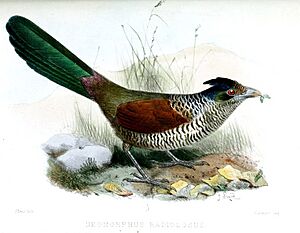Banded ground cuckoo facts for kids
Quick facts for kids Banded ground cuckoo |
|
|---|---|
 |
|
| Conservation status | |
| Scientific classification | |
| Genus: |
Neomorphus
|
| Species: |
radiolosus
|
 |
|
The banded ground cuckoo (Neomorphus radiolosus) is a special kind of cuckoo that lives mostly on the ground. It's an endangered bird, which means there aren't many left in the world. You can find this unique bird in the forests of Colombia and Ecuador.
Contents
What Kind of Bird Is It?
The banded ground cuckoo is a type of cuckoo bird. It's the only species in its specific group. However, it belongs to a larger family of ground cuckoos called Neomorphus. There are a few other similar cuckoos in this family.
What Does It Look Like?
The banded ground cuckoo is about 46 cm (18 in) (about 18 inches) long. Half of its length is its tail! It weighs around 400 g (14 oz) (about 14 ounces).
Adult Appearance
Adult cuckoos have a strong, curved beak. The top part of the beak is black, and the bottom part is grayish with a blue-gray tip. Both male and female birds look the same.
Their head is black with a shaggy, shiny, blue-black crest that can stand up. They have dark faces with bare blue skin behind their eyes. Their neck and upper back are shiny blue-black. The feathers on their upper back have white edges, making them look scaly.
Their lower back and rump are a rich maroon-chestnut color. The feathers covering their upper tail are a metallic green. Their tail is black with a purple and green shine. Their wings are black, with some purplish-red on the inner parts.
The feathers on their belly and chest are black and also look scaly, just like their upper back. The feathers under their tail are plain black.
Young Birds
Young cuckoos (juveniles) have mostly yellowish-brown scales on their bodies. They have some white on their chest. Their crest is blackish, but it doesn't have the blue shine that adults have.
Where Does It Live?
The banded ground cuckoo lives in a special area called the Chocó Ecoregion. This region is on the Pacific side of southern Colombia and the very northern part of Ecuador.
This bird is very rare and hard to find. It lives in wet tropical primary forest, which means old, untouched forests. You can usually find it at elevations between 700 and 1,200 m (2,300 and 3,900 ft) (about 2,300 to 3,900 feet) above sea level. Sometimes, they are seen a bit higher or lower.
How Does It Behave?
Movement
The banded ground cuckoo stays in the same area all year round. It doesn't migrate.
How It Moves
This cuckoo spends almost all its time on the ground. It mostly walks or runs through the forest floor. It might hop to catch prey. If it needs to escape danger or sleep, it might fly up into a tree.
What It Eats
The banded ground cuckoo hunts by running quickly along the forest floor. It stops suddenly to look for food and then catches it. It also hops onto low branches to grab prey from plants.
Its diet is mostly insects. It also eats other small creatures with exoskeletons, like spiders. Sometimes, it eats small animals like lizards, frogs, or even tiny birds. It might also eat fallen fruits.
Following Ants and Peccaries
These cuckoos often follow army ant swarms. Other birds do this too! They catch insects and other small animals that are trying to escape from the ants. They have also been seen following groups of peccarys (wild pig-like animals). They seem to do this for the same reason: to catch prey that the peccaries scare up.
Breeding and Nests
We don't know everything about when banded ground cuckoos breed. It seems to happen between March and June. Only two nests have been fully studied.
Nest Details
The nests were made mostly of fern leaves and didn't have much other support. They were placed in the forks of large branches, close to the trunks of medium-sized trees. These nests were about 3.9 and 5.4 m (10 and 20 ft) (about 13 to 18 feet) above the ground. Each nest held only one egg. Both parents helped to incubate the egg and care for the baby bird. The egg hatched in at least 13 days, and the young bird was ready to leave the nest in 20 days.
Sounds It Makes
The main sound the banded ground cuckoo makes is a deep "moo" sound, like a cow. This sound rises and falls and repeats about every five seconds. Cuckoo pairs and family groups use this call to talk to each other when they are hunting and can't see each other. They also make a dry clicking sound by clapping their beak together.
Mimicking Peccaries
Banded ground cuckoos have been seen making sounds that copy peccaries. This might be for two reasons. Peccaries can protect their group from predators. So, by sounding like peccaries, the cuckoos might trick predators into thinking peccaries are nearby. This could also help both the cuckoos and the peccaries by warning each other about predators.
Why Is It Endangered?
The IUCN (International Union for Conservation of Nature) has listed the banded ground cuckoo as an endangered species since 2009.
Threats to Survival
- Limited Range: It lives in a very small area.
- Specific Habitat: It needs a very particular type of forest to survive.
- Small Population: There are only an estimated 600 to 1,700 adult birds left. This small population is also spread out and separated into smaller groups.
- Habitat Loss: In most places where it lives, its forest home is being destroyed or damaged very quickly.
- Hunting: People also hunt this bird for food.
Because of these reasons, the number of banded ground cuckoos is believed to be decreasing.


